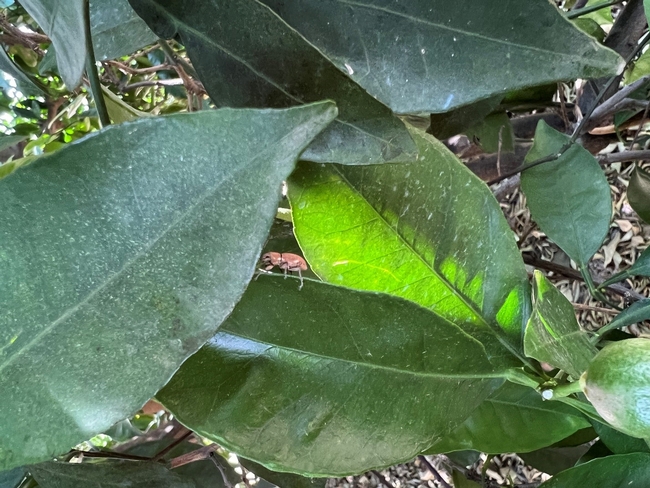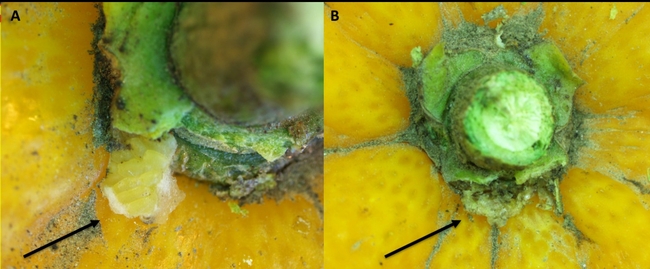USDA-APHIS Approves New Fuller Rose Beetle Mitigation – a Voluntary Option to Reduce Pesticide Applications
By
Sandipa Gautam, Area Citrus IPM Advisor UCCE
James R Cranney, President CCQC
At the request of the California Citrus Quality Council (CCQC) USDA's Animal and Plant Health Inspection Service (APHIS) has approved a new sampling protocol that growers can use to reduce pesticide applications for control of Fuller rose beetle (FRB), a quarantine pest in South Korea.
Fuller rose beetles are brown, flightless, snout beetles that have one generation in a year (Figure 1). Three-fourths of their life cycle is spent under the ground where they feed on roots and go through development. Adults emerge from the ground year-round, but the major emergence in the San Joaquin Valley occurs July-September, with 53% of beetles emerging in August. All beetles are females and adult females do not require mating to begin reproduction. Beetles climb to the tree canopy and feed on citrus leaves and lay eggs on cracks and crevices including the under the sepal (Figure 2). Eggs can be present at the time of harvest, thereby making this beetle a quarantine concern for Korea's Animal and Plant Quarantine Agency.
Figure. 1. Fuller rose beetle adult (right there, centered in the triangle).
Figure 2. Fuller rose beetle egg masses, live eggs (A) – note yellowish and plump eggs; dead or hatched eggs (B) – dried out egg mass.
Current Practices for FRB Management
Growers have been using a system's approach which combines cultural and chemical methods to target FRB, since 2010. The goal of FRB management is to reduce the beetle population and egg laying. Current regulatory requirements for managing FRB are
a) Skirt Pruning sufficient to prevent tree skirts from contacting the ground
b) Weed control sufficient to prevent forming a bridge from ground to tree skirt
c) Two insecticide treatments to control Fuller rose beetle using only University of California recommended pesticides from the UCANR IPM Guidelines web page at http://ipm.ucanr.edu/PMG/r107300311.html
In recent years, most growers and pest control advisors have reported that they no longer detect beetles in most citrus groves. Furthermore, the USDA APHIS interception rate from phytosanitary inspections, where 600 fruits per container are sampled for FRB egg masses, FRB was found in only 0.05 percent of all containers. This indicates that FRB populations are very low in citrus groves.
Since FRB populations in citrus groves are historically low, CCQC has proposed an additional voluntary option for the Korea FRB Protocol to reduce pesticide use:
- Trees must be skirt pruned to minimize branches touching the ground.
- Herbicide treatments should be made to eliminate weeds that could be a pathway into the tree.
- Either option a or option b
a) Growers must make two pesticide applications to control FRB using pesticides recommended on the University of California Citrus IPM website https://ipm.ucanr.edu/agriculture/citrus/fuller-rose-beetle/
b) Growers must use the FRB sampling protocol (below), keep records and if no more than two FRB-infested trees per sample are detected they may eliminate the first application and make one application, preferably before October 31 with pesticides recommended on the citrus IPM website.
Fuller Rose Beetle Sampling Protocol:
- Growers should conduct Fuller rose beetle (FRB) sampling from Aug. 7 – Aug. 31 since that is the peak period of emergence.
- Conduct a random sample in each citrus block.
- Divide the block into four quadrants and sample 18 trees that are spread equally apart in each quadrant. A total number of trees sampled is 72 trees.
- Growers or Pest Control Advisors (PCA) should:
i. Check suckers inside the tree for signs of FRB leaf chewing and if beetles are detected the tree is considered infested.
ii. If no beetles are found in the interior, shake two large outside branches over a light cloth and inspect for FRB. If beetles are found, the tree is considered infested.
- Growers must keep records on the results of the sampling including (i) block identification, (ii) inspection date, (iii) name of inspector, and (iv) number of trees infested with beetles out of 72 trees inspected.
- If no more than two infested trees are found, growers may eliminate the first FRB pesticide application. If two infested trees are found, growers must make a pesticide application in August or early September.
- If no more than two infested trees are found, growers are still required to make one pesticide application to control FRB, preferably before October 31.
How will the new protocol help?
- Reduced pesticide use could reduce grower costs to manage FRB.
- Fewer pesticide applications should improve biological control in citrus groves by preserving beneficial insects. Many PCAs and growers attribute severe mealy bug outbreaks to increased pesticide use to control FRB and Asian citrus psyllid.
- Reducing pesticide use to control FRB will help California citrus growers adopt more sustainable production practices and align the industry with the California Department of Pesticide Regulation's Sustainable Pest Management Roadmap.
References:
UCIPM 2017. Citrus Pest Management Guidelines: Fuller Rose Beetle. https://ipm.ucanr.edu/agriculture/citrus/fuller-rose-beetle/

